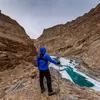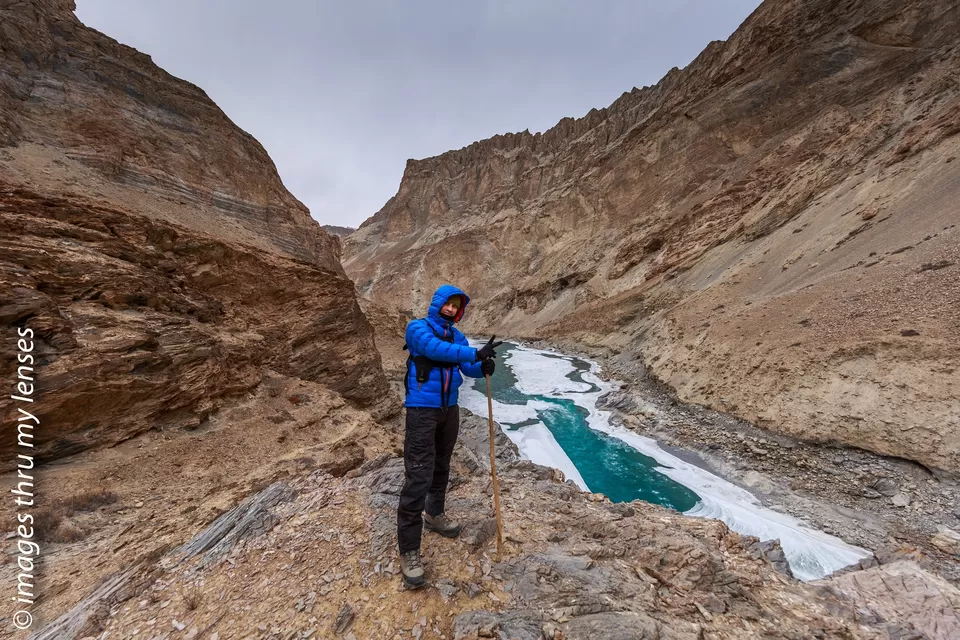One of the key aspects to the above is the clothing and if one goes wrong in this, the tenacity and success of the trek itself in addition to Self-Safety is in jeopardy. Just because it is cold does not mean that one cannot go outside and do what we want to do. But it takes planning and careful thought. If you are heading outdoors no matter what the season the easiest way to stay comfortable is to dress properly.
Layering is simply a strategy that emphasis versality and efficiency. Instead of bulking oneself with heavier items it is always better to put together an outfit with lighter items that can be removed or worn depending on the situation.
Layering is a tried and tested way to maximize the comfort. The success of this concept is that it allows one to make adjustments based on the activity level and changes in weather. Venturing into the Himalaya, one cannot predict the way the weather changes above 3000 mts. Hence one has to be prepared. I would be speaking on some of the terms that we use when we talk about preparation for outdoors in terms of clothing as well as how to choose what would be the correct and most flexible option.
First let’s begin with the terminology:
Base Layer: This is the next-to-skin layer.
Mid Layer: As the name indicates this is the middle layer catering to insulation.
Shell Layer: This is the outermost layer designed to deal with the elements of nature.
Powertec powder Dry: This patented technology used in base layers gives greater efficiency to the fabric improving drying performance and better performance using the characteristics of wicking in an improved design.
Synthetic Fabrics: These fabrics use powertec powder dry and related technologies in order to make state of the art base layer.
Merino Wool base layer: Over the years few brands have revolutionized the use of Merino wool for base layers.
Numbers alongside a particular model: The numbering alongside terms like midweight, lightweight, heavy weight indicate the warmth index. The higher the number, the higher the degree of warmth.
Fleece jacket: A lightweight jacket which uses polyester synthetic wool like polar fleece.
Down feather: The down refers to a layer of fine feather found under the tougher exterior feather in specific birds like goose, which are used as a fine insulator in jackets and sleeping bags.
GORE-TEX: Gore-Tex is a waterproof, breathable fabric membrane able to repel liquid while allowing water vapour to pass through.
VIBRAM: VIBRAM is a special material used in soles of mountaineering boots which has revolutionized the way Hiking/mountaineering boots.It provides excellent traction, abrasion resistance.
for detailed information on layering and several related articles , click on this link
Why Layering: a perfect natural query and I would like to summarize
(a) To keep oneself dry from the moisture that the body produces
(b) To keep the body heat trapped
(c) To keep the weather elements from affecting the body.
For a deeper understanding, let us begin:
Base Layer: This is the next-to skin layer. It helps in regulating the body temperature by moving the perspiration away from the skin and thereby keeping the body at a cool working temperature both in summer as well as winter. This layer is not meant to keep one warm, this needs to be remembered. Generally made of synthetic polyester, merino wool or sometime silk it offers breathability to the skin which is of paramount importance. Generally, preference is to be given to zip necked long sleeves models. Also to be kept in mind is that on long treks of over 05 days trekkers generally prefer only two pairs of base layers in order to minimize weight, hence the base layer should not smell as days pass by, is an important consideration while selecting. Never opt for cotton as it holds perspiration and that can play havoc with the working temperature of the body.


Mid Layer: The function of this layer is to provide insulation and retain the heat by trapping air close to the body. Generally opt for either synthetic material like polyester which are composed of Polartec , Thinsualte etc or go for natural fibers like wool , goose down which are excellent insulators. For extreme cold, natural fibers are definitely better however the biggest drawback is that when they come in contact with water, they become heavy and lose their properties. However newer innovations by brands like RAB(UK), ICEBREAKER etc are overcoming the above handicap. Base layers made of natural fibers are expensive too. These are graded as Light weight /mid weight /expedition weight depending on the climatic condition that the trek is being planned to and the season of the year.




I also recommend to opt for the thumb hole option base layer as these prevent the draft from blowing into the sleeve. Also do remember that once these two layers are worn the body should still have full flexibility.
Outer Layer: This layer is designed to protect the body from the elements of the weather and terrain. Hence it needs to be windproof, water proof as well as tough. This is an important layer and if this permits the wind, rain or snow to seep in, the inner layers too will not be able to function in the way they are designed. These should also be flexible and allow sufficient body movement. The outer shells generally use Gore –tex , eVent and durable water repellent (DWR) innovations to function as they have been designed. They are classified as soft shell, hard shell and insulated shell. Soft shell is a lighter version of the three and is generally popular however trekkers going to alpine heights/ above snow line/in winter opt for the hard shell or insulated shell.


The above categories apply to both upper and lower, now we move on to the other body parts that need attention.
Socks for feet: Socks can be insulated or hiking. Generally during the day in warm conditions , one should opt for wearing hiking socks as the feet are generating heat . However in case one is hiking in deep snow, definitely opt for woolen socks. At night in the camp, please wear twin layers of socks and if temperature is going down, opt for twin layer of woolen socks to provide insulation.
for detailed information on layering and several related articles , click on this link
Shoes: I would always recommend water proof, Gore Tex lined , VIBRAM soled hiking shoes. The other option is to select water proof, leather lined shoes. The advantages are that these shoes keep the heat generated within and the waterproofing protects the snow or water going inside. In case one is trekking in powdery snow, use gaiters to seal the mouth of the shoe.

Gloves: Definitely go for twin layers, the inner layer is the working glove to be used when the cold is manageable and there is no water crossing happening. Always better to have touch sensor enabled inner gloves so that one can use the camera or the phone easily without having to take the gloves off. The outer gloves are to be waterproof and insulated, to be used when the weather deteriorates and in the camps when there is less activity.


Cap: Once again have a twin selection of these. It is important to cover the ears, exposed face especially the lower half and the area behind the neck. Once can use a balaclava or a woolen cap for the same. The outer one can be a hoodie which is part of the Outer layer so that a combination can be used when it is snowing or raining.
Note. The above technique is applicable to all types of altitude treks in India no matter what time of the year it is attempted. Common brands available in India are Quechua, Woodland, Kilimanjaro, Columbia, Asolo . Premium brands like RAB , LOWA , Salomon, La Sportiva , Scarpa, Icebreaker, North Face, Marmot, Western Mountaineering, Mountain Hardware are nonexistent to get through stores in India, however they can be sourced through online retail.
for detailed information on layering and several related articles , click on this link


